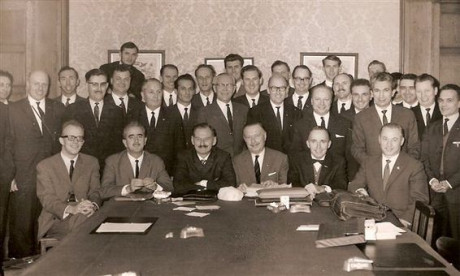"Braucht Architektur eine Frauenquote?"
Ja! 65%
Nein! 35%

(for the English Version please scroll down)
Kürzlich hat der Vorsitzende der Pritzker-Preis-Jury 2013 Lord Peter Palumbo im Namen der Jury eine über 18.000 Stimmen starke Online-Petition zurückgewiesen, nachträglich Denise Scott Browns Anteil an Robert Venturis Werk zu würdigen. Man könne Juryentscheidungen nicht rückwirkend ändern. Scott Brown hatte sich zuvor selbst kritisch darüber geäußert, daß 1991 ihr Partner Robert Venturi allein mit dem Preis ausgezeichnet wurde. Auch wenn ihre Äußerung in Richtung der Würdigung von Teamwork abzielte, scheint die Ehrung an den Frauen vorbeigereicht zu werden. 2012 wurde der Pritzker Preisträger Wang Shu gekürt - ohne seine Partnerin Lu Wenyu. Nicht, daß die Teilnahmebedingungen des Preises unverhandelbar währen: 2010 wurde mit der Verleihung des „Nobel-Preises der Architektur“ an Kazuyo Sejima und Ryue Nishizawa bereits zum zweiten Mal eine Ausnahme gemacht und nicht nur eine Einzelperson geehrt - jedoch genoss Kazuyo Sejima bereits größere Bekanntheit als ihr männlicher Partner.
Sei es Legos Produktlinie für Mädchen oder das generische Femininum an Universitäten – die Fragen, wie und ob man der Gleichstellung von Männern und Frauen gerecht werden kann, löst aktuell im Netz im Bezug auf diverse Lebensbereiche leidenschaftlich Diskussionen aus, an denen sich auch Architektinnen und Architekten beteiligen. Letztendlich geht es dabei um die Chancengleichheit von Frauen in ihrer beruflichen Verwirklichung. Abgesehen von den geringen weiblichen Besetzungen haben Frauen einen durchschnittlichen Stundenlohn, der 22% unter dem ihrer Kollegen liegt. Ähnlich verhält es sich beim Gehalt von Architektinnen. (lt. Analyse der Gehaltsstruktur der angestellten Mitglieder der Architektenkammern der Länder Baden-Württemberg, Niedersachsen und Nordrhein-Westfalen). Dabei haben in den letzten Jahren mehr Frauen als Männer das Architekturstudium abgeschlossen (Quelle: Destatis). In der Berufspraxis dreht sich dieses Verhältnis dann um. Nur 28,5 % der 105.408 in der Bundesarchitektenkammer registrierten Hochbauarchitekten sind weibliche Mitglieder. Darüberhinaus liegt der Frauenanteil der Freischaffenden unter einem Viertel. An den Hochschulen machen die weiblichen Stellenbesetzungen bei Professuren in den Ingenieurswissenschaften gerade mal 9% aus (Destatis). Und auch was die Berufsständische Vertretung angeht, sieht es mit zwei Frauen unter 16 Präsidenten der Länderkammern ebenfalls mau aus.
Begründet wird dieses Missverhältnis von Frauen und Männern im Architektenberuf meistens mit Arbeitsstrukturen, die in höheren Positionen kaum die Vereinbarkeit von Familie und Beruf zulassen. Frauen in der Architektur schaffen es also kaum, ihrer Qualifikation gemäß zu arbeiten und weil sie in der Minderheit sind, haben sie auch keine richtige Lobby. Sicherlich gibt es auch einige sehr erfolgreiche Architektinnen, mag man dagegen halten. Meistens sind es jedoch die Lebenspartnerinnen von Architekten, die wahrgenommen werden. Wie viele „alleinstehende“ Stararchitektinnen fallen einem schon ein jenseits von Zaha Hadid? Während in anderen Wirtschaftsbranchen lange schon über freiwillige Selbstverpflichtungen diskutiert wird (Beispiel Telekom), scheint es in deutschen Architekturbüros keinen Handlungsbedarf zu geben. Sind Architektinnen selbst schuld, weil sie ihre Rechte nicht offensiv genug einfordern? Haben Sie Angst, in der bei den Kollegen unbeliebten Emanzenecke zu landen? Ist es sogar besser, alles auf die Architektur zu setzen, anstatt sich für Gleichberechtigung einzusetzen, so wie Regine Leibinger, die sagt: “Ich bin kein Fan der Frauenquote, was zählt, ist gute Architektur.” (Morgenpost 28.12.11)? Oder sind die strukturellen Bedingungen der Architektur prinzipiell frauenfeindlich? Und wenn ja, gibt es noch Alternativen diese Strukturen aufzuweichen jenseits einer verordneten Quotenregelung?
"Does architecture need a quota for women?"
Lord Peter Palumbo, the current chair of the Pritzker Prize, and the 2013 Pritzker jury recently rejected an online petition to retroactively acknowledge Denise Scott Brown’s role in Robert Venturi 1991 Pritzker Prize. The petition, which received over 18,000 signatures, followed an address delivered by Scott Brown earlier this year, in which she criticized the 1991 Prizker Prize committee’s decision to recognize only her partner Robert Venturi. Scott Brown argued that their work was collaborative and that teamwork in architecture should be honoured. Lord Palumbo claimed simply that a jury’s decision cannot be changed retroactively. The Pritzker Prize, however, has a history of excluding women. Last year, for instance, Wang Shu, of Amateur Architecture, won the prize. Amateur Architecture’s female partner, Lu Wenyu, was not acknowledged. The reason given for this omission is that, traditionally, the prize is only awarded to an individual. However, the so-called “Nobel Prize of Architecture“ has been awarded to a team twice: Jacques Herzog and Pierre de Mueron in 2001 and to Kazuyo Sejima and Ryue Nishizawa in 2010. We suspect that, in the latter case, the joint prize was awarded partially because Kazuyo Sejima was more known than her male partner.
The questions of how and if gender equality can be achieved involve many areas of life; it’s a topic that’s passionately discussed in the media. Architects are also participating in this discussion. In architecture, the debate centers on leveling the playing field for men and women to pursue their professional careers. Numbers show that women are not faring as well in the profession as their male counterparts: only 28% of the 105, 408 registered members in the German Federal Chamber of Architects are female, even though, in recent years, more women than men have graduated from architecture schools. Additionally, only one quarter of freelance architects working in Germany is female. Women are underrepresented among the top positions in architecture firms; they also earn about 20 % less than their male colleagues in Germany (German Chamber of Architects). Female representation among German university professors is even worse: only 9% of the chairs in engineering and architecture departments are occupied by women (Source: Destatis). Only two of the sixteen German State Chambers of Architects are presided over by women.
Many blame the gap between men and women in the field on the profession’s working conditions, which make it difficult to juggle family commitments with professional ones. As a minority, women also do not have a good lobby to champion their needs and secure proportional representation. There are some successful female architects, but they often work in husband-and-wife teams or in greater partnerships. How many “single” female architects can the average person name, other than Zaha Hadid?
In business, a voluntary commitment to increase the number of women in leading positions has been widely discussed and even recently introduced (for example, by the Deutsche Telekom). Enforcing a quota for women, however, does not seem as urgent an issue in the architecture profession. Are women in architecture to blame because they do not fight aggressively enough for their position? Are they afraid of being seen as latter-day suffragettes? The successful German architect Regine Leibinger of Barkow Leibinger has said: “I’m not a fan of a women’s quota. What counts is good architecture.” (Source: Morgenpost 28.12.11). Is it better for female architects to concentrate on the outcome of their work rather than on their position? Or are working conditions in architecture too discriminatory for architecture to become a meritocracy of talent and effort ? If yes, are there alternatives, other than a mandatory quota, to support equal opportunities for women and men?
Statements in English are welcome!
Ja ...
Jein ...
Jein ...
Jein ...
Ja ...
Ja ...
Jein ...
Jein ...
Nein ...
Nein ...
Ja ...
Nein ...
Ja ...
Nein ...
Nein ...
Jein ...
Nein ...
Ja ...
Ja ...
Nein ...
Nein ...
Jein ...
Ja ...
Nein ...
Jein ...
Jein ...
Nein ...
Nein ...
Ja ...
Nein ...
Nein ...
Ja ...
Jein ...
Nein ...
Jein ...
Quotas are heavy handed and perhaps an overly simplistic way to deal with an issue as complex as the lack of women in the design and construction fields where cultural change is so urgently needed. Without the equitable participation of women in architecture, our industry and our built environment will continue to suffer. While grass roots or “bottom up” support for women to achieve licensure and position themselves for leadership positions are extremely important, without the support of “top down” leadership, the necessary cultural change cannot be achieved. I support clear goals for the promotion of women and minorities to effect change and send a strong signal that the contributions of women are valued both culturally and monetarily. Carefully tracked metrics (only 17% of American Institute of Architects (AIA) members are women according to the 2012 AIA Survey) are a useful tool to underscore the necessity for programs that help groom and retain women – particularly those at mid-career who are most vulnerable to attrition – for leadership positions. It is critical that we hold up an unbiased mirror (the data tells the real story) to begin to unravel how women are marginalized and evaluate our progress forward.
Julia Murphy has joined SOM (Skidmore, Owings & Merrill LPP, NY) in 2008 and has served as a Project Manager, working on multiple large-scale, complex commercial and mixed-use projects. Her recent large-scale projects include the Manhattan West Development and the Busan Lotte Town Tower. A leader in the SOM community, Julia is a Member of the SOM Women’s Initiative Committee, a group devoted to the professional development of women within the firm.
1
0
0


